


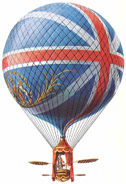
Vincenzo Lunardi's Hydrogen Balloon 1784
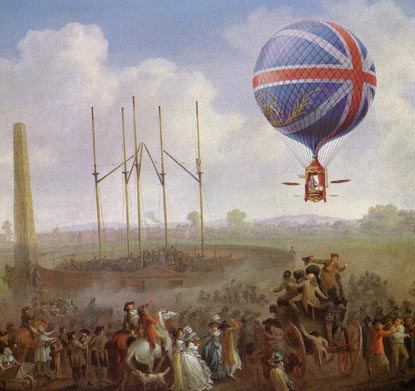 Vinny Lunardi was at his best playing to the crowd that always came to see him ascend. This is a painting of the balloon he created "in tribute to everything British". The poles in the background held the balloon as it was inflated. |
Vincent Lunardi:
 It was not until almost a year after the invention of the balloon that the English were convinced of man's conquest of the air. A number of attempts were made but they turned out so badly that people were skeptical of the craze for flying which had swept over France.
It was not until almost a year after the invention of the balloon that the English were convinced of man's conquest of the air. A number of attempts were made but they turned out so badly that people were skeptical of the craze for flying which had swept over France.
On September 15, 1784, Vincent Lunardi, a young Italian, demonstrated the success of his French predecessors before a great multitude in London including the Prince of Wales and many eminent statesmen. In a hydrogen balloon, brightly decorated, Lunardi ascended with a dog, a cat, and a pigeon, and traveled 24 miles.
His friend George Biggin had planned to accompany him, but the impatience of the crowd forced Lunardi to make the attempt before the bag was completely inflated. The British were immediately captivated by the fad of ballooning and Lunardi became the most sought after person in London. This is a model of the colorful balloon Lunardi made "in tribute to all things British".
Thank you for the wonderful 'Lunardi Balloon'. Is was a pleasure to build and is very decorative in our boy's room. You made my son very happy. Best regards, Christain
Vincenzo Lanardi's Ballon
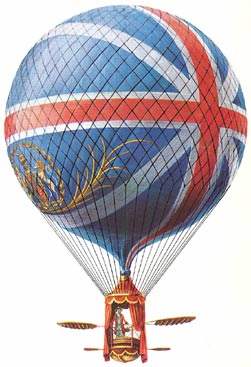 Vincenzo Lunardi, the "Daredevil Aeronaut", was a
flamboyant young Italian whose balloon ascents in Scotland were
very successful and totally eclipsed those of James Tytler, Scotland's
first aeronaut. Lunardi was a popular hero of the period, and
the Lunardi bonnet, a balloon shaped hat about 2 feet high, and
Lunardi skirts, which were decorated with balloon motifs, were
the vogue fashion accessories of the time.
Vincenzo Lunardi, the "Daredevil Aeronaut", was a
flamboyant young Italian whose balloon ascents in Scotland were
very successful and totally eclipsed those of James Tytler, Scotland's
first aeronaut. Lunardi was a popular hero of the period, and
the Lunardi bonnet, a balloon shaped hat about 2 feet high, and
Lunardi skirts, which were decorated with balloon motifs, were
the vogue fashion accessories of the time.
Lunardi made a number of flights in Scotland and adverts in the
Glasgow Mercury in early November 1785 announced that he intended
to "gratify the curiosity of the public of Glasgow, by ascending
in his Grand Air Balloon from a conspicuous place in the city".
The Grand Air Balloon, which was made of 1500 feet of green, pink
and yellow silk, was exhibited, "suspended in its floating
state" in the choir of Glasgow's cathedral for the admission
charge of one shilling. On the 23rd November 1785, an immense
crowd gathered in St Andrew's Square to witness the flight. The
weather was fine and at around 2pm, Lunardi "ascended into
the atmosphere with majestic grandeur, to the astonishment and
admiration of the spectators" the flight path was not entirely
visible because of cloud, but the balloon was seen passing over
Hamilton and Lanark before finally making a good landing near
Hawick in the Borders, where he landed at the feet of "trembling
shepherds", the journey of 110 miles had taken 2 hours.
Lunardi's second ascent a few weeks later started off with a near
calamity, when a character, known as Lothian Tam, in his eagerness
to get a close view of the flight became entangled in the balloon's
ropes and was lifted 20 feet into the air until he was released
and fell to the ground with no serious injury. The weather on
this trip was much more blustery and Lunardi made a hard landing,
after 20 minutes, in Campsie Glen around 12 miles from Glasgow.
On 20 December, he made an ascent from the grounds of Heriot's Hospital in Edinburgh. A strong wind was blowing and Lunardi was forced down in the sea after a flight of 70 minutes. Fortunately he was picked up by a fishing boat after some time in the water and landed at North Berwick.
The balloon ascents of Vincenzo Lunardi in Great Britain:
Vincenzo Lunardi made the first balloon ascent in Great Britain
on 15 September 1784. Lunardi was born at Lucca in Italy on 11
January 1759 and, after spending his childhood in the East Indies,
was at a relatively early age employed by the Neapolitan ambassador
in London, Prince Caraminico.
Lunardi was then a good-looking, temperamental and vainglorious youngster who soon established himself in the gay and hectic life prevailing in the British capital of that period. He believed that he would become still more attractive by taking up ballooning at a time when the achievements of the French aeronauts were the current topic in fashionable places. Lunardi was a dandy, yet endowed with much common sense and well aware of his lack of knowledge in the new field of aeronautics.
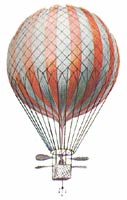 For this reason he associated
himself with one of his friends, George Biggin, who enjoyed the
reputation
of being a patron of the arts. Before the construction of a balloon
could be tackled it was necessary to find a suitable place for
its ascent. Lunardi first tried to obtain permission to go up
from the grounds of the Chelsea Hospital. However, somebody else
had already beaten him to it - a Frenchman, de Morel, who had
made the first attempt with a whimsical hot air balloon shaped
like a Chinese temple.
For this reason he associated
himself with one of his friends, George Biggin, who enjoyed the
reputation
of being a patron of the arts. Before the construction of a balloon
could be tackled it was necessary to find a suitable place for
its ascent. Lunardi first tried to obtain permission to go up
from the grounds of the Chelsea Hospital. However, somebody else
had already beaten him to it - a Frenchman, de Morel, who had
made the first attempt with a whimsical hot air balloon shaped
like a Chinese temple.
This monster declined to leave the ground, which disappointed and infuriated the spectators; in their rage they destroyed the balloon as well as some surrounding property. Dr John Sheldon did not fare much better; his captive balloon also was damaged and he abandoned his ascension attempt. It was thus readily understandable when the management of the Chelsea Hospital refused to grant permission for Lunardi to use its grounds for his balloon ascent.
However, the commander of the Honorable Artillery Company, Sir Watkin Lewis, finally overcame official reluctance and placed the Moorfields training grounds, on the northern outskirts of London, at Lunardi's disposal - with the proviso that from his collected money an amount of £500 was to be set aside to guarantee coverage of any possible damage caused and the sum of £100 established as a fund for the benefit of the family of a recently-deceased artillery officer. Now Lunardi could finally proceed with his arrangements to have built a hydrogen balloon of the Charles type. It was, strangely enough, not fitted with a valve on top and so became dangerous and difficult to handle. The enlarged netting arrangement, on the other hand, introduced a distinct improvement feature, for the cording was reduced first to 'crows' feet' from which the leading cords were fastened to a hoop from which the car was suspended. The car itself also was of a more practical form and devoid of superfluous, heavy ornamentation.
The envelope of the balloon was made of oiled silk, and had a diameter of 33' ft which resulted in a volume of 18,200 cu.ft A chemist, Dr George Fordyce, was in charge of the filling and also built the equipment for manufacturing the hydrogen. The ascent took place in the early afternoon of 15 September 1784. It had taken all of the previous night and the whole of the morning to fill the balloon, and the 100,000 or more restless and impatient spectators rendered the task all the more difficult.
There was no way of predicting how they might react if kept waiting too long, so the decision was made that Lunardi was to ascend alone in the balloon, which was not yet quite filled, and leave Biggin behind on the ground. Lunardi was accompanied by a dog, a cat and pigeon, and provisions were amply supplied. A special stand had been erected for the Prince of Wales who was present and he tipped his silk hat in deference as the balloon began to rise. Everybody else present followed the royal example. There was a hushed atmosphere of fear and doubt; not a sound was heard.
Lunardi, who had hopes of advancing through the air by rowing, had brought along oars of different shape, one of which broke when he started. But he remained convinced that the oars were instrumental in his reaching a cornfield near North Mimms, some 13 miles north of London. Here he landed at 3.30 p.m., divested himself of his remaining ballast and released the cat, which by now was quite benumbed with cold. Though Lunardi throughout the trip had stayed at altitudes of below 1,000 ft, he had registered temperatures as low as -16°C.
This is the first hydrogen balloon
Lunardi launched in England. It was the first to ever be launched
in the Kingdom. 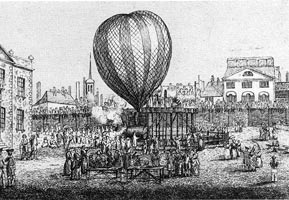 |
Now that the balloon was relieved of some weight it rose again and Lunardi jotted down and dropped a flowery report about the esoteric clouds below him and the sun sparkling the wide landscape. From this it is evident that this time he climbed to a higher altitude. Some thirty minutes later the balloon once more landed softly in a meadow near the town of Ware in Hertfordshire. The scared farmers at first refused to approach this 'devilry' until a girl, who was also present and much impressed by the finely-dressed young gentleman who had descended from the sky in his pretty red- and blue-striped balloon, grasped one of the lines; then the others pitched in to help, though with some hesitance. This first balloon ascent in Great Britain turned Lunardi into the hero of the hour and, dressed in the honorary uniform of the Artillery, he was presented to King George III.
A monument was erected on the spot where Lunardi landed for the second time; its popular name is Long Mead, and it is still there. Lunardi went on to build larger and better balloons and ascended once more from Moorfields. On this occasion his balloon was decorated with a huge Union Jack, in which manner he 'wished to express his respects and devotion to everything which the word "British" stands for'. His faithful friend Biggin and a Mrs Letitia Sage, an actress, were to have accompanied him on this trip, but once more the lifting capacity of the balloon was poor, so Lunardi started alone on 13 May 1785. Soon afterwards he had to come down again, near Tottenham Court Road, because the envelope turned out to be leaking. The well-tried patience of Biggin was finally rewarded later that year when, on 29 June, he was able to ascend himself, accompanied by Mrs Sage.
This trip lasted an hour and had the distinction of being the first time 'a British female air travelers' had gone aloft. This was the term by which Mrs Sage henceforth liked to be described. She was a beautiful lady, but from a ballooning point of view she unfortunately tipped the scales at 2001b. Lunardi made several more balloon ascents in Great Britain during 1785, but in August 1786 one of his young assistants lost his life in a tragic accident. During the preparations for an ascent at Newcastle upon Tyne, Ralph Heron was pulled aloft as one arm got entangled in the anchor rope when the balloon took off prematurely. The rope broke and the hapless youngster plunged to his death. Lunardi was not to blame, yet, after the incident, everywhere he went in Great Britain he was now persecuted as intensely as he had previously been acclaimed. He left the country for good, but continued his balloon ascents in Italy, Spain and Portugal. His health later failed, and he died in Portugal on 31 July 1806.
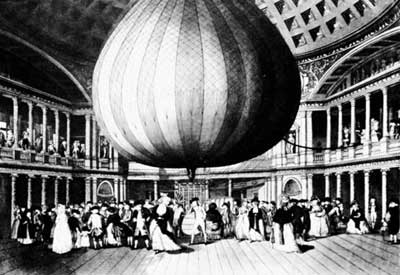 Exhibition of Lunardi's balloon at the Pantheon. |


